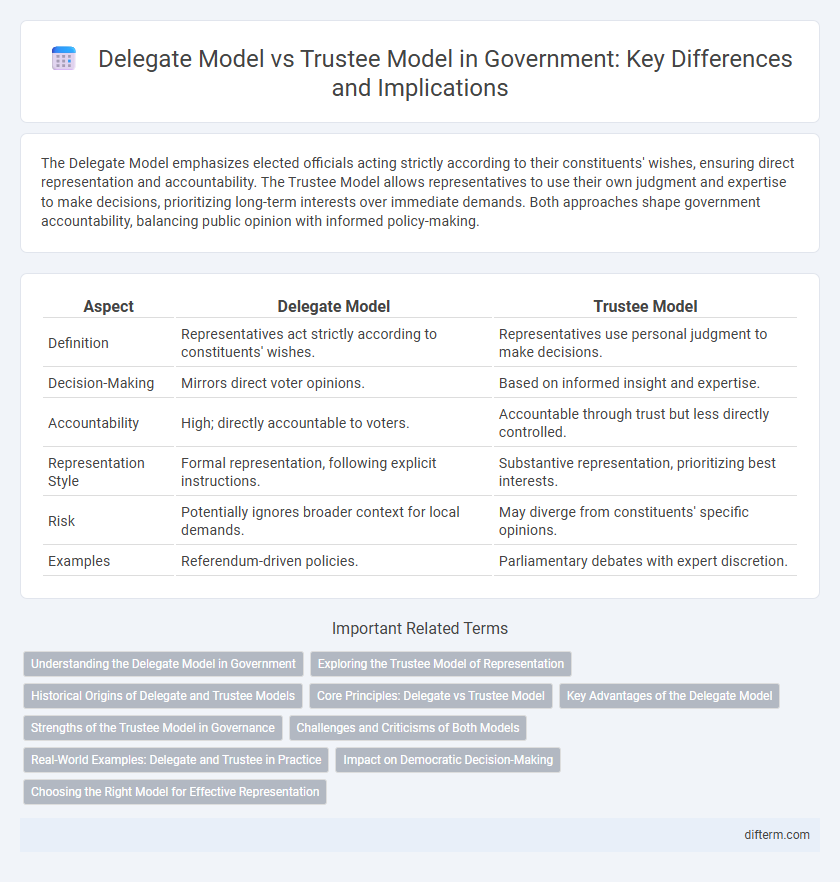The Delegate Model emphasizes elected officials acting strictly according to their constituents' wishes, ensuring direct representation and accountability. The Trustee Model allows representatives to use their own judgment and expertise to make decisions, prioritizing long-term interests over immediate demands. Both approaches shape government accountability, balancing public opinion with informed policy-making.
Table of Comparison
| Aspect | Delegate Model | Trustee Model |
|---|---|---|
| Definition | Representatives act strictly according to constituents' wishes. | Representatives use personal judgment to make decisions. |
| Decision-Making | Mirrors direct voter opinions. | Based on informed insight and expertise. |
| Accountability | High; directly accountable to voters. | Accountable through trust but less directly controlled. |
| Representation Style | Formal representation, following explicit instructions. | Substantive representation, prioritizing best interests. |
| Risk | Potentially ignores broader context for local demands. | May diverge from constituents' specific opinions. |
| Examples | Referendum-driven policies. | Parliamentary debates with expert discretion. |
Understanding the Delegate Model in Government
The Delegate Model in government emphasizes representatives acting strictly according to their constituents' preferences, ensuring direct reflection of the public's will in decision-making processes. This model fosters accountability through constant communication and responsiveness to voter demands, limiting personal judgment or discretion by elected officials. It contrasts with the Trustee Model, where representatives exercise independent judgment, prioritizing informed decision-making over strict adherence to constituent opinions.
Exploring the Trustee Model of Representation
The Trustee Model of Representation entrusts elected officials to use their own judgment and expertise to make decisions that serve the long-term interests of their constituents, rather than strictly adhering to the immediate wishes of voters. This model emphasizes the role of representatives as independent agents who balance diverse interests and complex policy considerations in governance. Studies in political science highlight that trustees prioritize informed decision-making and ethical responsibility, often leading to more nuanced and sustainable policy outcomes.
Historical Origins of Delegate and Trustee Models
The Delegate Model and Trustee Model of representation trace their roots to Enlightenment political philosophy, with the Delegate Model emphasizing the direct implementation of constituents' wishes as advocated by thinkers like Jean-Jacques Rousseau. The Trustee Model, influenced by Edmund Burke's speeches in the 18th century, posits that elected officials exercise their own judgment and expertise to make decisions for the public good, even if contrary to immediate public opinion. These foundational theories shaped the principles of democratic governance and representative accountability still debated in modern political institutions.
Core Principles: Delegate vs Trustee Model
The Delegate Model centers on elected officials acting strictly according to their constituents' expressed preferences, ensuring direct representation and accountability. The Trustee Model empowers representatives to use their own judgment and expertise to make decisions in the best interest of the public, prioritizing informed leadership over immediate constituent demands. Both models reflect fundamental principles of democratic governance, balancing responsiveness with responsibility.
Key Advantages of the Delegate Model
The Delegate Model ensures elected officials closely reflect the explicit preferences of their constituents, enhancing democratic accountability. This model promotes transparency by requiring representatives to act strictly according to voters' mandates, minimizing the risk of personal bias or arbitrary decision-making. It fosters a stronger connection between the electorate and their representatives, improving responsiveness to local concerns and priorities.
Strengths of the Trustee Model in Governance
The Trustee Model in governance empowers representatives to make informed decisions based on expertise and long-term public interest rather than immediate popular opinion. This model strengthens accountability by allowing delegates to exercise independent judgment, fostering stability and consistent policy implementation. It prioritizes thoughtful analysis and ethical responsibility, enhancing the quality of governance outcomes.
Challenges and Criticisms of Both Models
The Delegate Model faces challenges such as oversimplification of complex policy issues and the risk of pandering to popular opinion at the expense of long-term interests. The Trustee Model is criticized for potentially enabling government officials to act with excessive autonomy, which may reduce accountability and increase the risk of disconnect from constituent preferences. Both models struggle to balance responsiveness with effective governance in democratic systems.
Real-World Examples: Delegate and Trustee in Practice
The Delegate Model is exemplified by representatives who closely follow constituent instructions, such as U.S. House members who often vote in alignment with district preferences to maintain voter support. In contrast, the Trustee Model is demonstrated by figures like former U.S. Senator John McCain, who prioritized personal judgment and expertise over direct constituent demands when making policy decisions. These real-world cases highlight the practical application of each model in balancing responsiveness and independent judgment within democratic governance.
Impact on Democratic Decision-Making
The Delegate Model emphasizes representatives acting strictly according to their constituents' preferences, ensuring direct reflection of public opinion in decision-making. The Trustee Model allows elected officials to use their judgment and expertise, potentially leading to more informed policy outcomes but with less direct accountability. The impact on democratic decision-making hinges on balancing responsiveness with responsible governance to maintain legitimacy and effectiveness.
Choosing the Right Model for Effective Representation
Selecting the appropriate model between Delegate and Trustee is crucial for effective representation in government. The Delegate Model emphasizes direct responsiveness to constituents' preferences, ensuring elected officials act as their immediate voice. In contrast, the Trustee Model empowers representatives to use their judgment and expertise, balancing public opinion with informed decision-making for long-term benefits.
Delegate Model vs Trustee Model Infographic

 difterm.com
difterm.com